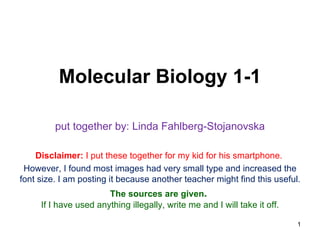
Molecular Biology 1-1
- 1. Molecular Biology 1-1 put together by: Linda Fahlberg-Stojanovska Disclaimer: I put these together for my kid for his smartphone. However, I found most images had very small type and increased the font size. I am posting it because another teacher might find this useful. The sources are given. If I have used anything illegally, write me and I will take it off. 1
- 3. KEYWORDS Life is the primary characteristic of organisms. Organism is any connected living system capable of • response to stimuli, • reproduction, • growth and development • adaptation to environment • homeostasis Homeostasis is the property of organisms • regulates its internal environment • maintains a system of stable constant conditions like • temperature or pH. 3
- 4. KEYWORDS Cell is the basic structural and functional unit of an organism. The main purpose of cell is to organize. Organelle is a subunit within a cell with a specific function. It is usually membrane-bound. Tissue is a layer of cells that are alike and work together for a specific function. Tissue is the cellular organizational level between cells and a complete organ. Organ is a • functional group of multiple tissues • relatively independent part of the body • carries out one or more special functions 4
- 5. Organisms can be classified as: - single-cellular - multi-cellular Prokaryotes: bacteria and archaea Eukaryotes: all other organisms! Viruses are not organisms or cells. 5
- 6. Prokaryotes • unicellular • no cell nucleus • no mitochondria • no membrane-bound organelles Neither their DNA nor sites of metabolic activity are collected together in a discrete membrane-enclosed area. Instead, everything is openly accessible within the cell, some of which is free-floating. 6
- 7. Prokaryotes vs. Eukaryotes 7 teacherweb.com/IND/.../PROKARYOTIC_CELL_new_part_2.do c
- 8. Developmental Eras • Earth is probably 4.5 billion years old • 3.8 billion years of simple cells (prokaryotes = bacteria and archaea) • 3 billion years of photosynthesis, • 2 billion years of complex cells (eukaryotes), • 1 billion years of multicellular life, • 600 million years of simple animals, 8
- 9. Cell Size Bacteria • microbacteria ~150 nm • E. coli 1,5 µm x 5 µm • Exceptional: ~10 µm up to >100 µm Human Cells: • erithrocytes ~ 8 µm • ovum (egg) ~ 100 µm • nerve cells ~ 4 µm – 100 µm 9
- 10. CELL Cell is the basic structural and functional unit of an organism. Humans contain about 10 trillion (1013) cells. Most plant and animal cells are • between 1 and 100 µm • Visible only under the microscope. http://toolboxes.flexiblelearning.net.au/demosites/series3/308/laboratory/studynotes/SN- 10 OilImmer.htm
- 12. KEYWORDS Evolution is a science that investigates the development of species. Creationism is the belief that life on Earth was created directly by a supernatural being. Phylogeny is the science that studies the evolutionary relationships between groups of organisms (populations, species, ...). Taxonomy is a system of classification of organisms into groups according to their relationships and evolutionary development 12
- 13. Evolution and Mutation Start with: • Common origin of species. • Genetic changes accumulate and lead to the emergence of new characteristics. • Genetic changes are the result of mutations, introduction of new genes or recombination of genes. • New characteristics are inherited. • Natural selection: the environment represents a selection pressure to force only characteristics that represent an advantage for survival and reproduction. • When populations are separated, different characteristics are selected and new species develop. 13
- 14. Evolution and Mutation 14 http://en.wikipedia.org/wiki/File:Mutation_and_selection_diagram.svg
- 15. Classification Organisms - Domains Category: Domain There are 3 domains. - Bacteria - Archaea - Eukaryotes In 1990, the category “Domain” was added after C. R. Woese distinguished Bacteria and Archaea based on differences in their rRNA 16S The three-domain system adds the level of classification Domains above the level of Kingdoms. 15
- 16. Taxonomy DOMAIN Eukaryota 16 http://en.wikipedia.org/wiki/Domain_%28biology%29
- 17. Kingdoms = 6 Prokaryotes: eubacteria, archaebacteria Eukaryotes: protista, plants, animals, fungi History of Kingdoms Linnéas: 2 (animals and plants) ~1960: 4 basic divisions prokaryotes and eukaryotes ~1969: 5 (fungi is added) ~1980: 6 17 http://www.emc.maricopa.edu/faculty/farabee/biobk/biobookdiversity_3.html
- 18. History of Taxonomy On the Earth there are 5-100 million different species of organisms. They differ in morphology, biochemical and genetic characteristics. The first really successful attempt at grouping of organisms was carried out by Linnaeus with the introduction of species and genera. Species representing "all instances of creatures” that are each equal to the smallest details of physical structure. Darwin: " “all true classification is genealogical” Ernst Mayer (~ 1940): biological species is a population or set of populations who can breed with each other and have fertile offspring. 18
- 19. Keywords • Morphology (biology): the study of the form or shape of an organism. • Biochemical Characteristics: characteristics which describe the chemical substances and vital processes occurring in living organisms. • Genetic Characteristics: characteristics which are related to heredity and the variation of inherited characteristics among similar or related organisms. 19
- 20. Genotype vs. Phenotype Genotype: All of the genetic code of an organism. Phenotype: All of the properties of an organism. Phenotype reflects the genotype, as well as environmental influences (diet, climate, injuries, lifestyle, …). http://www.bbc.co.uk/schools/gcsebitesize/science/edexcel/genes/genesrev_print.shtml 20
- 21. Phylogenic Tree Phylogenic tree can be drawn on the basis of: - similaritiesbetween organisms (fosils and their age, anatomy,…) - differences between their amino acids and proteins - differences between nucleotides in their DNA and RNA Differences based on molecular biology is called molecular phylogeny. A node (taxa) joined together in the tree implies “descended from a common ancestor”. 21
- 22. Phylogenetic Tree for the 3 Domains 22 http://en.wikipedia.org/wiki/Phylogenetic_tree
- 23. Dots indicate common ancestor. Numbers indicate “relative” amount of change in genome. Phylogenetic tree based on similarities between genome sequences. The genome is an organism’s complete set of DNA. 23 https://www.llnl.gov/str/June05/Ovcharenko.html
